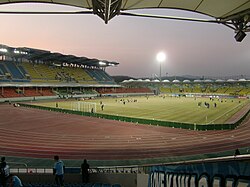Tancheon Sports Complex
Fortress Tancheon | |
 | |
 | |
| Former names | Seongnam 2 Sports Complex |
|---|---|
| Location | 215, Tancheon-ro, Bundang-gu, Seongnam, Gyeonggi-do, South Korea |
| Coordinates | 37°24′31″N 127°07′20″E / 37.408614°N 127.122256°E |
| Operator | Seongnam |
| Capacity | 16,146 |
| Field size |
|
| Surface | Grass |
| Construction | |
| Broke ground | August 1997 |
| Opened | 1 April 2002[1] |
| Construction cost | 112.1 Billion KRW |
| Tenants | |
| Seongnam FC | |
Tancheon Sports Complex (Template:Lang-ko) is a group of sports facilities in Seongnam, South Korea. Its name was Seongnam 2 Sports Complex but changed to Tancheon Sports Complex in January 2006, naming after Tancheon.[1] The complex consists of the Tancheon Stadium, Tancheon Baseball Stadium and a Sports Club.[2]
Facilities
Tancheon Stadium
Tancheon Stadium is a multi-purpose stadium built in 2002 and currently used mostly for football matches and has been the home stadium of Seongnam FC since 2005, replacing the club's previous home, the Seongnam Sports Complex.[3]
The first professional football match ever held was a friendly game between Seongnam Ilhwa Chunma and Poland national football team on 26 May 2002.[4]

In 2009, Seongnam FC moved their home matches to Seongnam Sports Complex as the canopy installation works commenced.[5] The installation was completed in 2010. The first match held since the installation was Seongnam FC's 2010 AFC Champions League game against Kawasaki Frontale on 23 February 2010.[6]
On 12 March 2016, the stadium recorded its first ever K League sold-out match in Seongnam FC's 2016 K League Classic first-round game against Suwon Samsung Bluewings.[7]
In the first half of 2019, Seongnam installed the nation's best large electronic display panel at Tancheon Stadium. Fan would be able to enjoy more vivid game scenes and halftime events at the stadium. In order to improve players' performance, the grass was completely replaced, and track and field tracks was also replaced with blue ones. The team's color was applied to the stadium with street lamp banners and branding using Tongcheon.[8]
The stadium is nicknamed the Tancheon Fortress (Hangul: 탄천요새) reflecting Seongnam FC's strong home record[9] in AFC Champions League.[10]

Tancheon Baseball Stadium
The stadium is equipped with AstroTurf and a stand with 955 seats. From Mondays to Saturdays, the stadium is mostly used by the city's high school baseball teams for home games and practices. For public use, applicants need to apply to a draw for empty time slots.[2]
Tancheon Sports Club
The complex building includes swimming pool, squash court, aerobic exercise centre, ice rink, multi-purpose gym, health club, tennis court, bowling alley, and indoor golf facilities.[2]
In popular culture
In the quarantine camp scene in the South Korean disaster film, Flu (2013), infected persons are placed in plastic bags, with some of them still alive, thrown into a pit in Tancheon Stadium, and incinerated. Mir (Park Min-ha is brought to the pit of bodies to be incinerated but is rescued by Kang Ji-goo (Jang Hyuk). The uninfected people see the pit, and a riot ensues, forcing the evacuation of all medical and military personnel from the camp.[11]

References
- ^ a b 탄천종합운동장 연혁 [History of Tancheon Complex]. Tancheon Sports Complex (in Korean). 2017-02-20. Archived from the original on 2016-01-06. Retrieved 2017-02-20.
- ^ a b c "시설소개 | 탄천종합운동장". www.2ssc.or.kr (in Korean). 2017-02-20. Archived from the original on 2016-01-06. Retrieved 2017-02-19.
- ^ "데이터센터 | 한국프로축구연맹 - 현대오일뱅크 K리그 클래식/챌린지". www.kleague.com (in Korean). Retrieved 2017-02-20.
- ^ "폴란드, 성남 일화에 2-1 진땀승". legacy.www.hani.co.kr. 2002-05-26. Retrieved 2017-02-20.
- ^ "성남, 성남종합운동장으로 홈 경기장 변경". No 1. 축구전문 콘텐츠 기업 스포탈코리아. 2017-02-20. Retrieved 2017-02-20.
- ^ '확 변했다!' 지붕 덮인 성남의 탄천경기장 (in Korean). 2010-03-01. Retrieved 2017-02-20.
- ^ "뉴스 | 한국프로축구연맹 - 현대오일뱅크 K리그 클래식/챌린지". www.kleague.com (in Korean). Retrieved 2017-02-20.
- ^ "'탄천 복귀' 성남, 경기장 재정비 완료...14일 대구전부터". 2019-07-11. Retrieved 2020-04-17.
- ^ "Arnold aiming to ruin Seongnam's strong home record". Central Coast Mariners. Retrieved 2017-02-22.
- ^ "성남시민프로축구단 : 성남FC 서포팅가 홈페이지 업로드 안내". Retrieved 2017-02-22.
- ^ 탄천종합운동장이 살처분장으로?. 씨네21 (in Korean). 2013-08-13. Retrieved 2017-02-20.
External links
- Official website (in Korean)
- Seongnam FC Official Site (in Korean)
- World Stadiums
- Football venues in South Korea
- Athletics (track and field) venues in South Korea
- Rugby union stadiums in South Korea
- Sports complexes in South Korea
- Sports venues in Gyeonggi Province
- Seongnam FC
- Sports venues completed in 2002
- Buildings and structures in Seongnam
- 2002 establishments in South Korea
- K League 1 stadiums
- K League 2 stadiums
